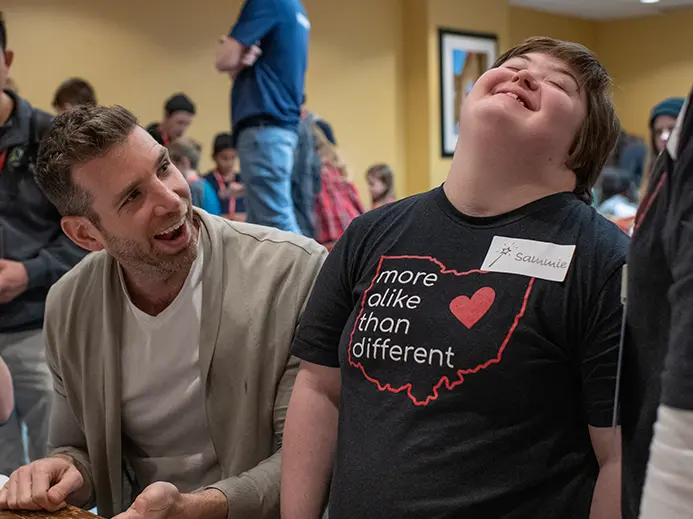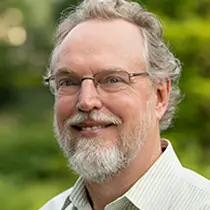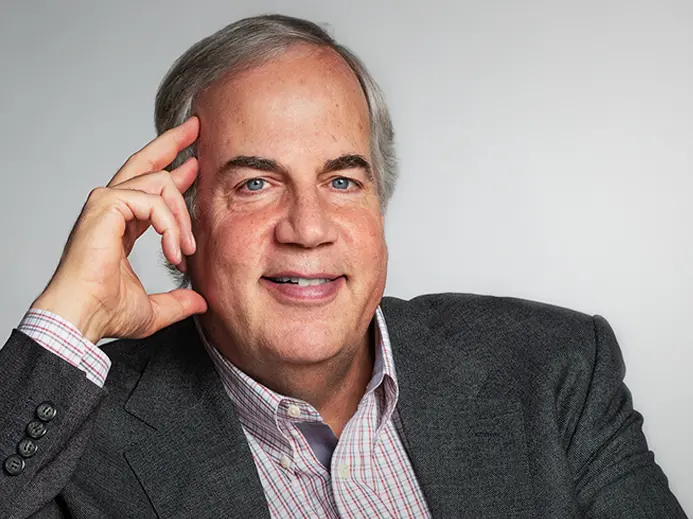
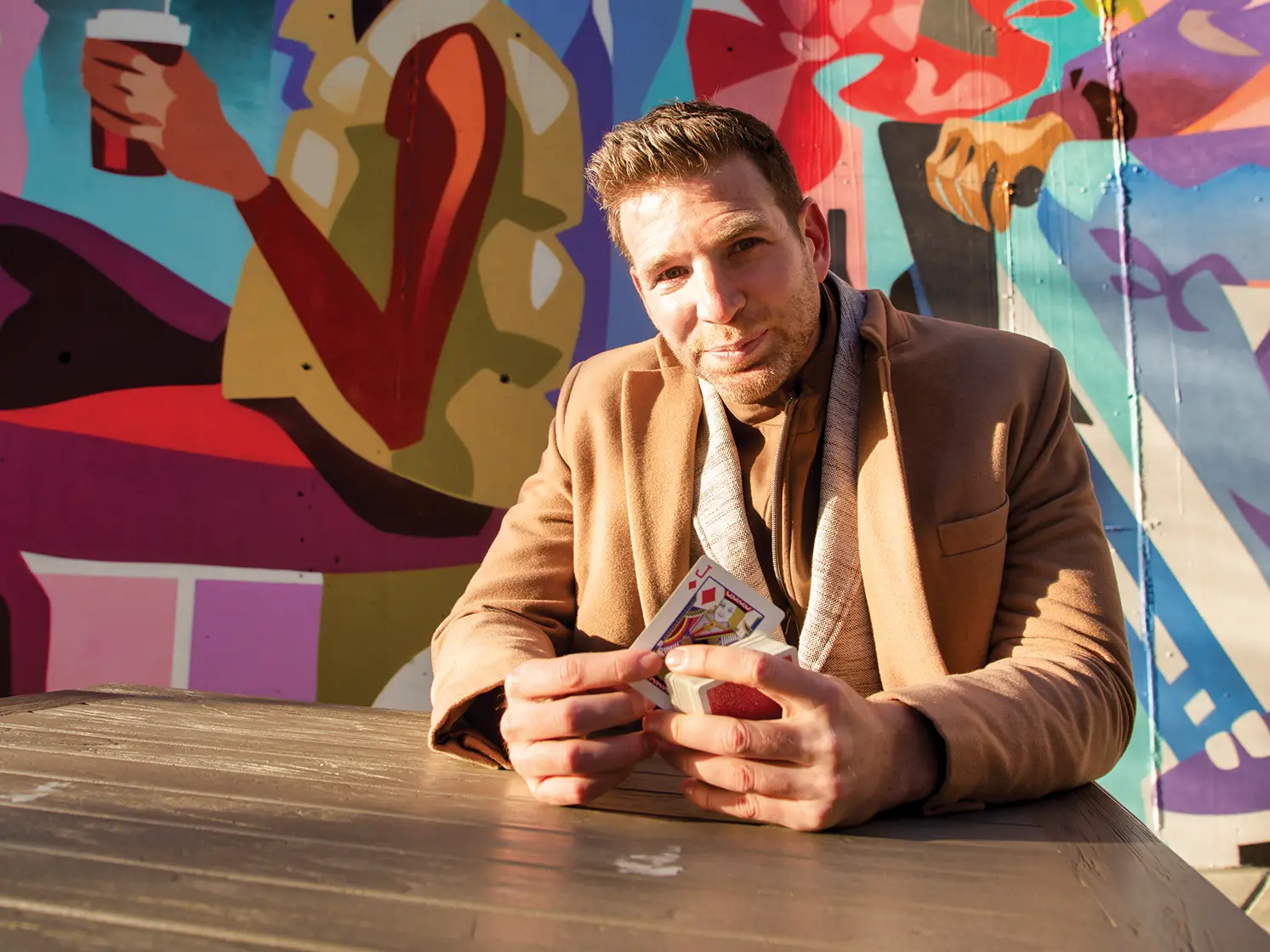
Every little thing Joshua Jay does is magic
Cards and quarters. Distractions and decoys. These are the tools of many magicians. But Joshua Jay is more. He is a storyteller, a mentor, a businessman, a podcaster, a showman, an author, a friend. And, oh yes, a Buckeye.
A woman held the small music box. Round and round she cranked the side handle, creating a song in the gift shop of the J. Paul Getty Museum in Los Angeles.
Joshua Jay glanced over, and the fleeting moment became illuminating. His mind churned with ideas for magic tricks, as it has for more than three decades.
“Magic is the lens through which I see the world,” Jay says. “It’s about looking at things in a way that others may not see them.”
Being open to different avenues of thinking is a central reason his childhood obsession evolved into a profession that has brought him worldwide renown.
It’s also why, despite fame and accolades, he stood in the Getty gift shop on that day in 2019 as a curious observer.
What if …?
He saw more than a little wooden music box. He saw possibilities.
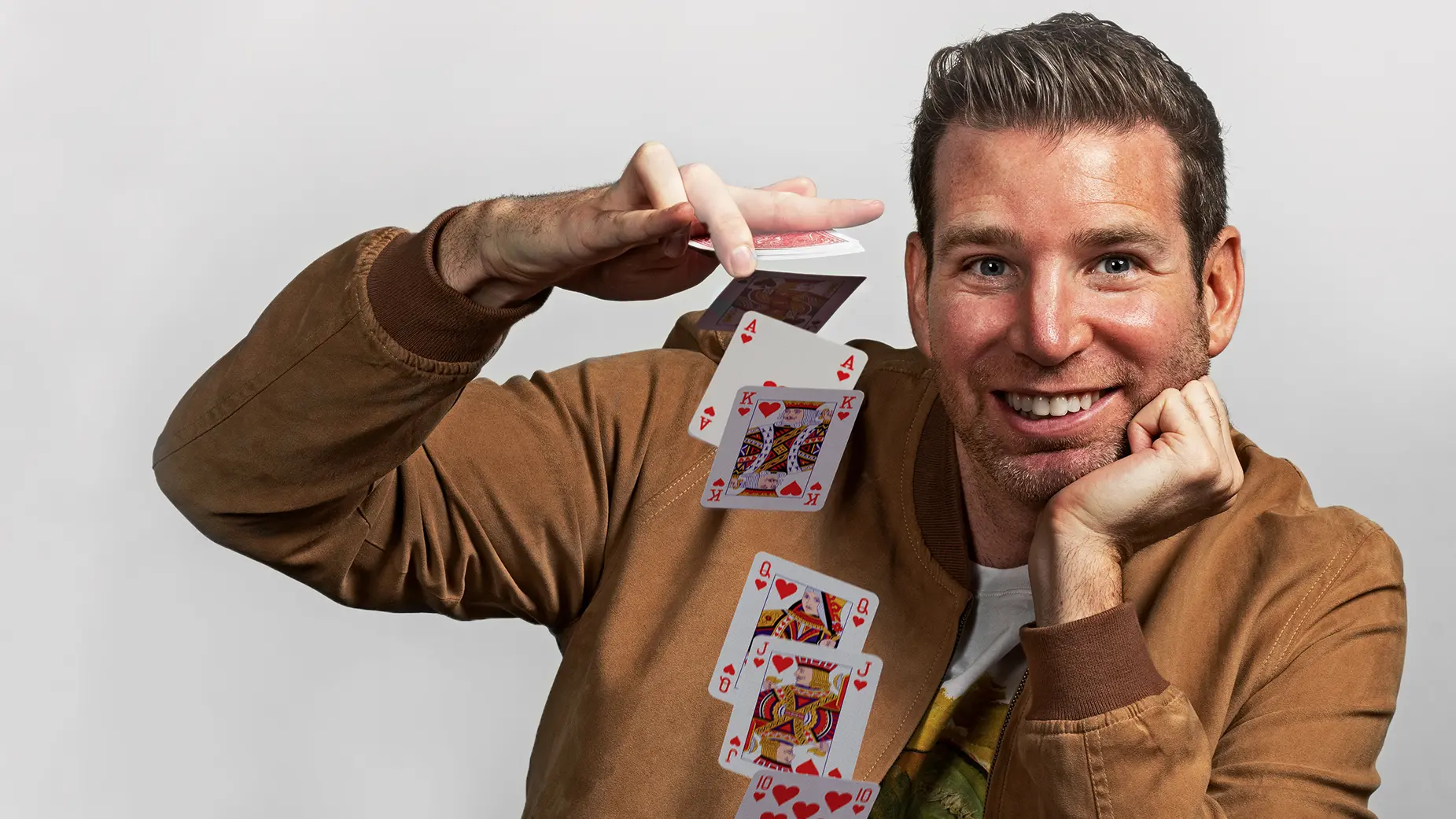
In this video, Joshua Jay talks about how magic is about storytelling. Run time is less than 2 minutes. (Video produced by Randy Walk)
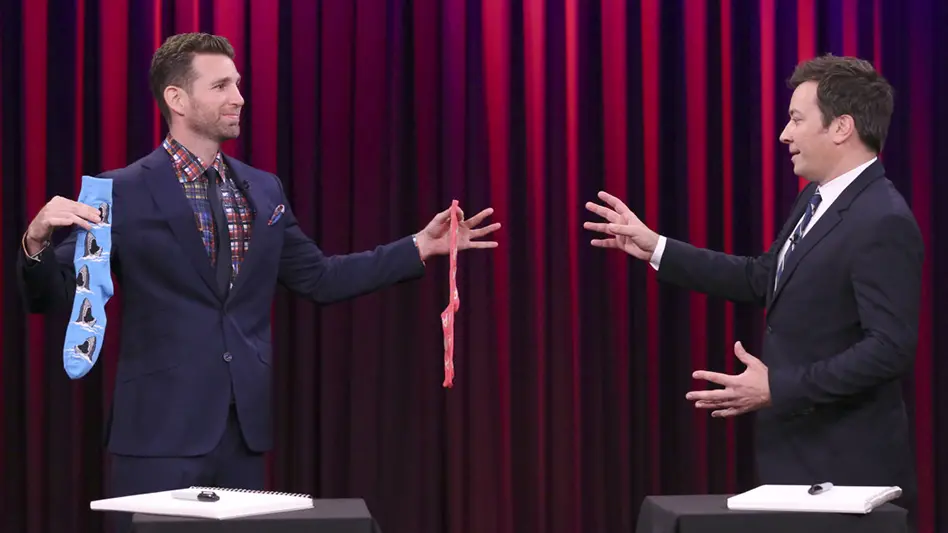
Jay’s rise to the top of his craft has led to many national TV appearances, such as this guest spot on The Tonight Show Starring Jimmy Fallon in 2018. (Photo courtesy of Joshua Jay)
No one would begrudge the 39-year-old Jay some boasting. The Society of American Magicians named him “Magician of the Year” in 2020, two years after recognizing him with its highest proclamation for his contributions to the art of magic.
Beyond ample award presentations and trips abroad, magic has taken Jay off-Broadway, where he presented his own show, Six Impossible Things, and to the sets of such TV mainstays as Good Morning America, The Tonight Show Starring Jimmy Fallon, Penn & Teller: Try This At Home and Masters of Illusion. It’s also made him a go-to consultant: Jay collaborated with HBO to design illusions for Game of Thrones and the U.S. Postal Service on the design of its stamp series on magic.
Despite his in-demand expertise, he has a relentless yearning to learn.
“I feel like a lifelong student,” says Jay, who practices for a couple hours each day. “The enemy of any kind of mastery is feeling like you have arrived. You’re in a constant state of growing and evolving.”
Jay’s hunger for knowledge ran unabated as an Ohio State student. His curiosity was wrapped in poise, confidence and an easygoing manner, leaving an indelible impression on faculty members.
“I have taught at Ohio State since 1988, and he is in my top three or five most memorable undergraduates ever,” says English Professor Michelle Herman, who served as Jay’s thesis advisor and stays in regular touch. “He was curious and had lots of ideas about things. He really was always in the thick of any discussion, always interested and engaged. He was so present in every class he took.”
At times Jay had to miss class for unconventional reasons. He’d fly to Japan or Europe to do corporate shows or other performances, all while maintaining good grades in the honors program. He leveraged opportunities to study abroad in France and Ecuador. His appreciation grew for being open to what could be.
“Ohio State was all about possibilities — it was never about what couldn’t be done,” Jay says. “My professors encouraged me and showed me, ‘Hey look, not everybody who is an English major has to end up being a journalist or a writer. You can have unusual paths and use that degree.’ I discovered that even with magic as my endpoint, getting there didn’t have to be a linear path.”
His study of creative nonfiction helped Jay think differently about performing. He realized that all magic is storytelling, and that’s true beyond the presentation of individual tricks. Providing context and history deepens an audience’s appreciation for magic and has helped Jay push boundaries.
“My career has been about trying to express a point of view or narrative in my work,” he says. “I do this because my impulse is to express myself on stage, not just perform meaningless tricks one after another. It’s also about raising the craft, performing pieces in a way that makes people think. It’s my way of broadening the audience’s perspectives.”
This intent played out on that October night in 2019 when Jay returned to campus to discuss Reginald Scot’s Discoverie of Witchcraft. He informed the Ohio Union crowd about the history of the book, considered to contain the first published (in 1584) accounts in English of magic as illusion. And he performed tricks inspired by Scot’s book.
Jay was by himself on stage, but not alone. He fostered collaboration. Audience members bonded with him, and each other, in laughter, wide eyes and audible oohs. “You make a difference,” he told them.
It’s all about how you think. “If people come with an open mind and are ready to be transported,” Jay says, “then, truly, the possibilities are pretty exciting.”
The magician who performed at the Union that night — and earlier for President Obama’s 2008 inauguration and President Clinton’s Global Initiative fundraiser — sat at a table with 9-year-old Benjamin Morey and watched with a surgeon’s eye as the child shared a card trick.
“Whoa,” says Jay, his 6-foot-3 body hunched down to share the boy’s eye level. “That was great. You had a good pace to it. It was awesome. Clean. Well done.”
Jay high-fived Benjamin. The child beamed. He had recognized Jay from YouTube. But the boy’s mother saw a lot more in the magician as she observed how he interacted with her son.
“He is an extremely passionate person, but not just about magic itself,” says Nichol Morey ’04 MA of Huber Heights, Ohio. “He’s passionate about expanding magic, getting more people involved, and a lot of that has to do with the youth.”
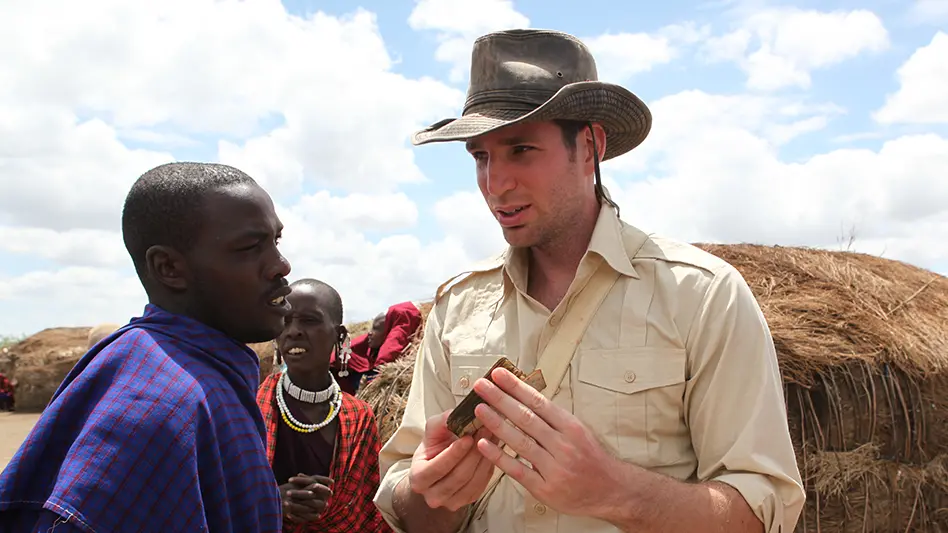
All the world is a stage for Jay, whose magic career has taken him to 117 countries. Here he performs for children in a Maasai village in Tanzania. (Photo courtesy of Joshua Jay)
The Moreys were at Magifest in January 2020. The pandemic hadn’t yet disrupted life, and more than 1,000 magicians — most of them adults — were attending the annual Columbus magic convention Jay co-owns and operates as a labor of thanks.
“My life was changed forever by positive experiences I had at Magifest,” says Jay, who became obsessed with magic at age 7 when his father, Jeffrey Jay ’72, ’75 DDS, showed him a card trick. He began performing a year later, and father and son annually made the trip from their Canton, Ohio, home for Magifest. The nation’s oldest magic convention honored Jay at age 14 for winning a trick contest. Dreams blossomed.
“I had huge ambitions as a teenager,” Jay says. “I wanted to be on television and on big stages. I wanted to make lots of money. That drive served me well in some ways, but after you reach those goals, it becomes a crutch. What’s next? When you realize it isn’t a race, and the only thing that matters is the work, that’s when things get really interesting.”
Jay says empathy is the greatest life lesson magic has taught him. It’s led him to roles beyond entertainer. Roles tied to thinking of others.
For the past decade, Jay has corresponded with prisoners who initially wrote to him for tips, because magic helps them deal with isolation. His company, Vanishing Inc., has run the nonprofit ShareMagic to assist magicians in need and by providing props, mentorship and more than 400 scholarships for children around the world to attend magic shows, events and conventions.
Jay has traveled to Cape Town, South Africa, to visit the College of Magic, which teaches leadership and public-speaking skills to disadvantaged children. His charity built a new theatre for that nonprofit school in 2016 and has since raised donations for renovations. He’s also hosted and visited young magicians from Colombia in a partnership with Magicians Without Borders.
“For me, it comes back to the positive help that I received as a kid,” Jay says. “Now it’s just what feels right. I have wisdom to offer, and I know that any time I spend with young magicians is going to push the craft forward. It’s my obligation. It’s also quite fun.”
Magifest is especially enjoyable for Jay because of how the event shaped him. His gratitude led him to award scholarships to 45 kids for last year’s conference, which included a performance by Gahanna Lincoln High School students with special needs.
“Josh brings with him a worldview,” says Jep Hostetler ’68 PhD, an Ohio State professor emeritus of public health who served as Magifest chair for 29 years, until 2009. “It’s not just about magic for him. It’s about generosity.
“I’m one of his biggest supporters and biggest fans because of his integrity and how he treats children. He’s investing and training young people to think magically, to think about wonder, to think about more than just doing tricks.”
More than just magic was going on at Magifest in January 2020, when crowds were a normal part of life. As magicians young and old mingled in a hotel hallway during a break in sessions, two teenagers sat at a table and performed card tricks for Jay.
“Wow, that was great, and from a shuffled deck,” Jay says. “I’m so impressed. Does that mean I get to show you one? I don’t know how I’m going to top that one.”
Jay began a trick. Six more kids wandered over to watch. A few shuffles and tricks later, a dozen adults had joined, encircling the table. Within 10 minutes, the original audience of two had grown to 30, and everyone clapped as Jay somehow rearranged the position of four aces.
“Josh! Josh! Josh!” they chanted.
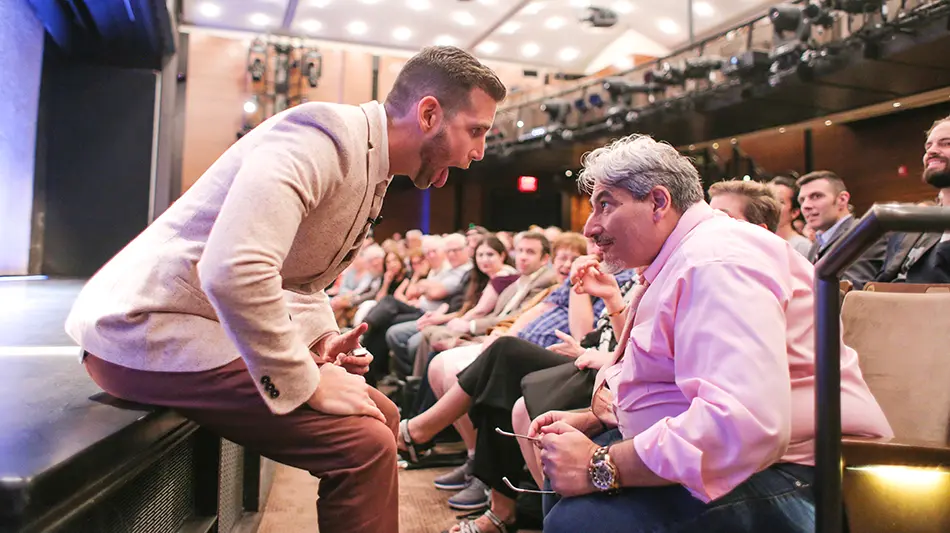
Audience members become partners in Jay’s performances, as seen during this pre-pandemic show. “To me,” he says, “magic shows are about bringing people together.” (Photo courtesy of Joshua Jay)
Mystery is part of magic. The audience isn’t given answers to how tricks are performed. To fully enjoy an act, Jay says, one must be willing to not understand what is taking place. To accept uncertainty.
“Every good trick leaves us with questions,” he says.
So does life, especially since COVID-19 changed the world.
Jay has been fortunate to have good health during the pandemic, and his Vanishing Inc. business has adapted well enough to retain all 12 employees. He had a children’s book, Magic Mail, published last year and another one, The Dream Machine, in February. His next book, How Magicians Think, comes out in September.
Still, fallout from the virus has challenged Jay. He’s been forced to find new meaning in old ways of doing things, especially regarding his act — the hub of his career’s ecosystem. How do you perform magic using cards and everyday objects to astonish people up close when people aren’t gathering in person?
Confronted with that question, Jay took solace in knowing he wasn’t alone. Everyone has been facing their own questions in this COVID world. The virus has created uncertainty and a common need to be open to possibilities.
“We’ve all had to learn that lesson in the pandemic,” Jay says. “We’ve all had to embrace not knowing and not understanding.”
Jay had faced uncertainty in his career before. In 2009, he was riding on an inner tube behind a boat traveling 55 mph when he collided with a metal buoy on northeast Ohio’s Turkeyfoot Lake. His left wrist was badly broken.
“I thought my magic career would be over. I was sure of it,” Jay says. “I was sure I wouldn’t get use of my left hand back — and I’m a lefty — because two surgeons told me I wouldn’t.”
Three surgeries incapacitated Jay for months. He began training how to do magic tricks with one hand while undergoing physical therapy five days a week. He also thought a lot. “I had to recalibrate how I developed my original material,” he says.
Jay regained the use of his left hand (although he still has no feeling in one finger), and his career flourished until COVID suddenly canceled shows and shut down the whirlwind schedule that had him on the road as many as 300 days a year. Now what?
“If you can’t interact with people, you have no show,” Jay says. “Magic is not something the magician does for you. Magic is something we make together. Community is what makes that possible.”
Jay resisted for months the idea of performing shows online. He says technology doesn’t help magic; a camera limits a magician’s ability to redirect the audience. And doing a series of tricks with people following along on screens seemed flat, unfulfilling to him.
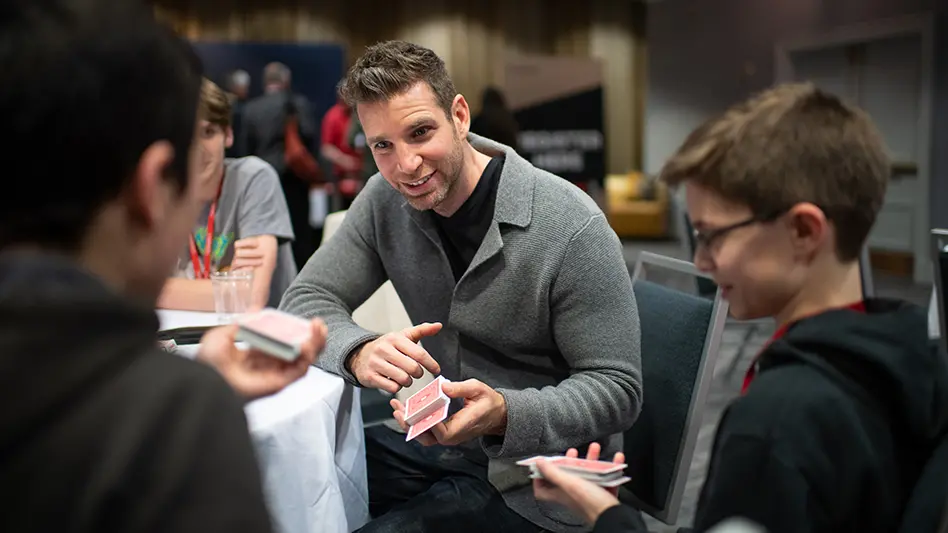
Jay demonstrates a card trick for young magicians at Magifest. “Somewhere in this room is the next great magician, and I have an obligation to show that person this path,” he says. (Photo by Jo McCulty)
“I want my magic to be meaningful,” Jay says. “I want people to find more in it than deception. People should enjoy magic, of course, but they should also feel connected to others through it.”
Jay pondered how to connect an audience in these strange circumstances. His solution? Let people into his personal space. He’d perform online from his New York City apartment, where he could show an audience his extensive collections of artifacts and books tied to magic. He’d tell stories, take questions, provide history and context. Explain how magicians think.
“I wasn’t into it, and then something clicked: I can make the connection by chatting with people,” Jay says. “They’re curious about an art form they don’t know much about. Well, now we’re on to something really meaningful.”
Magic took on more meaning for Jay six months into the pandemic when he performed online from home the first time. Hundreds of people joined him. He saw something different on faces.
“We’re going through something, and I’ve never seen audiences more starved for entertainment,” Jay says. “Yes, it’s togetherness on Zoom, where everybody’s piped in via their videos and their phones. It’s a different kind of community, but it’s needed.
“All of a sudden, magic never felt more relevant. What I never felt before the pandemic was a sense of urgency, a sense of importance to the magic. When I’m doing these shows, I really feel like I’m giving them something that they need, which is community.”
An online gathering of 600 — including famous magicians David Copperfield and Penn & Teller — formed on a night last March to watch Jay host his virtual show, How Magicians Think.
Jay performed tricks, adding explanations that offered peeks behind the curtain. He took questions, repeating each person’s name. He shared his rare copy of Scot’s Discoverie of Witchcraft, a straight-jacket Houdini used in 1924, a pair of Cardini’s white gloves and other historic props.
There were smiles and laughs, an escape for everyone, magician or not.
“Magic is about making people question what they think they know,” Jay says. “It’s about shattering what we thought was possible. And that’s a great space to play in during difficult times. I really feel empowered.
“There’s nothing we can’t adapt to and get through if we work together and pool our mental resources. It gives me hope. What’s clear is people will always look for and need astonishment. When they’re looking for it, I’ll be there.”
